CNA156 Reflective Essay: Aboriginal and Torres Strait Islander Health
VerifiedAdded on 2022/10/01
|8
|1887
|6
Essay
AI Summary
This reflective essay explores the crucial aspects of ensuring the health and wellbeing of Aboriginal and Torres Strait Islander peoples. The essay emphasizes the importance of cultural safety, self-determination, and collaboration in healthcare practices. It discusses the need to address social inequalities and implement culturally sensitive healthcare strategies. The author, drawing from personal interactions and experiences, highlights the significance of community engagement, respecting cultural values, and the role of Aboriginal health workers. The essay advocates for a non-discriminatory healthcare system, the implementation of the 'Closing the Gap' initiative, and the use of anti-racism strategies. Furthermore, the essay suggests counseling and early intervention services to support the mental and social well-being of the community. The author concludes that by prioritizing self-determination, cultural security, and collaborative efforts, healthcare systems can achieve positive health outcomes and enhance community well-being for Aboriginal and Torres Strait Islander peoples.
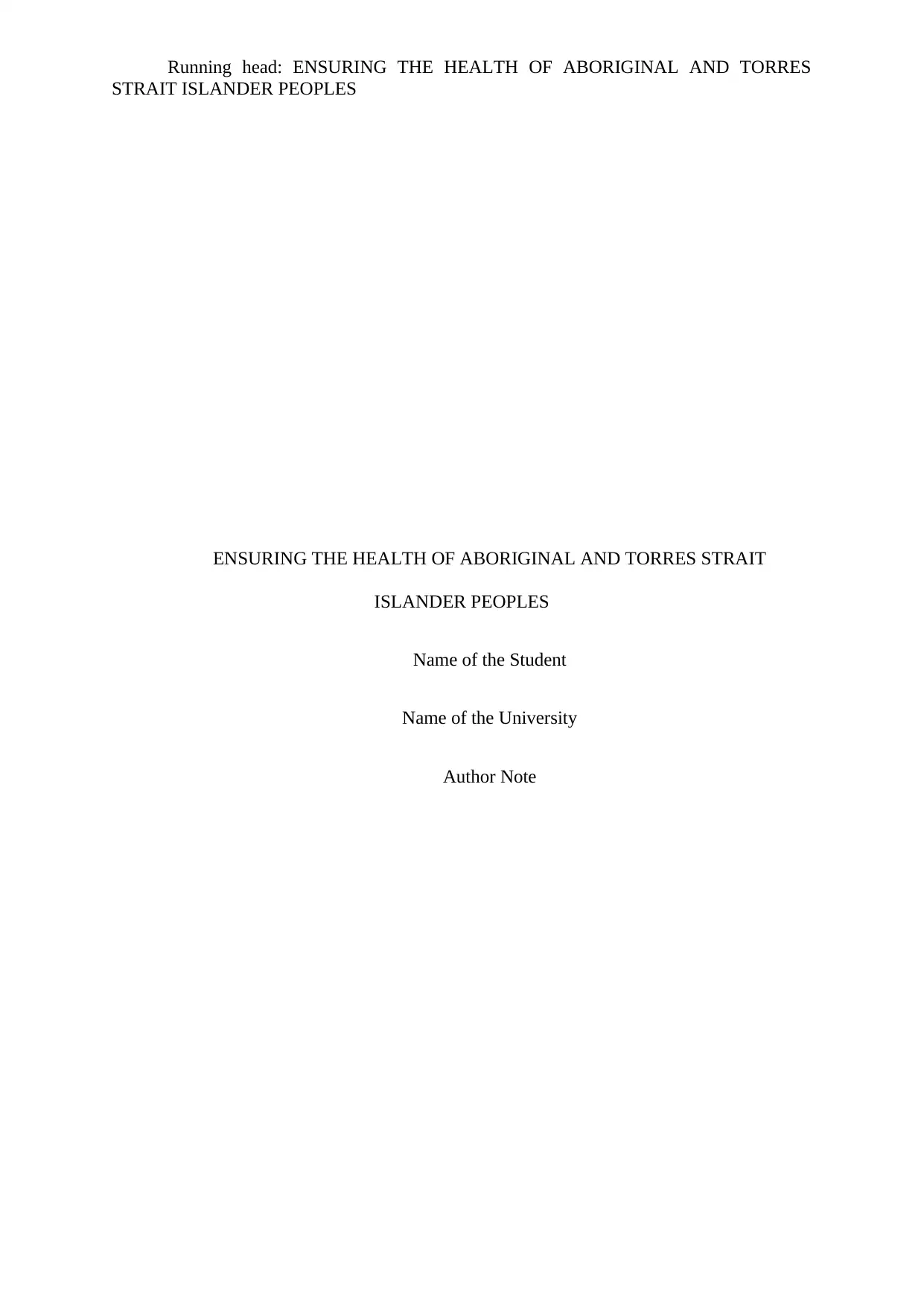
Running head: ENSURING THE HEALTH OF ABORIGINAL AND TORRES
STRAIT ISLANDER PEOPLES
ENSURING THE HEALTH OF ABORIGINAL AND TORRES STRAIT
ISLANDER PEOPLES
Name of the Student
Name of the University
Author Note
STRAIT ISLANDER PEOPLES
ENSURING THE HEALTH OF ABORIGINAL AND TORRES STRAIT
ISLANDER PEOPLES
Name of the Student
Name of the University
Author Note
Paraphrase This Document
Need a fresh take? Get an instant paraphrase of this document with our AI Paraphraser
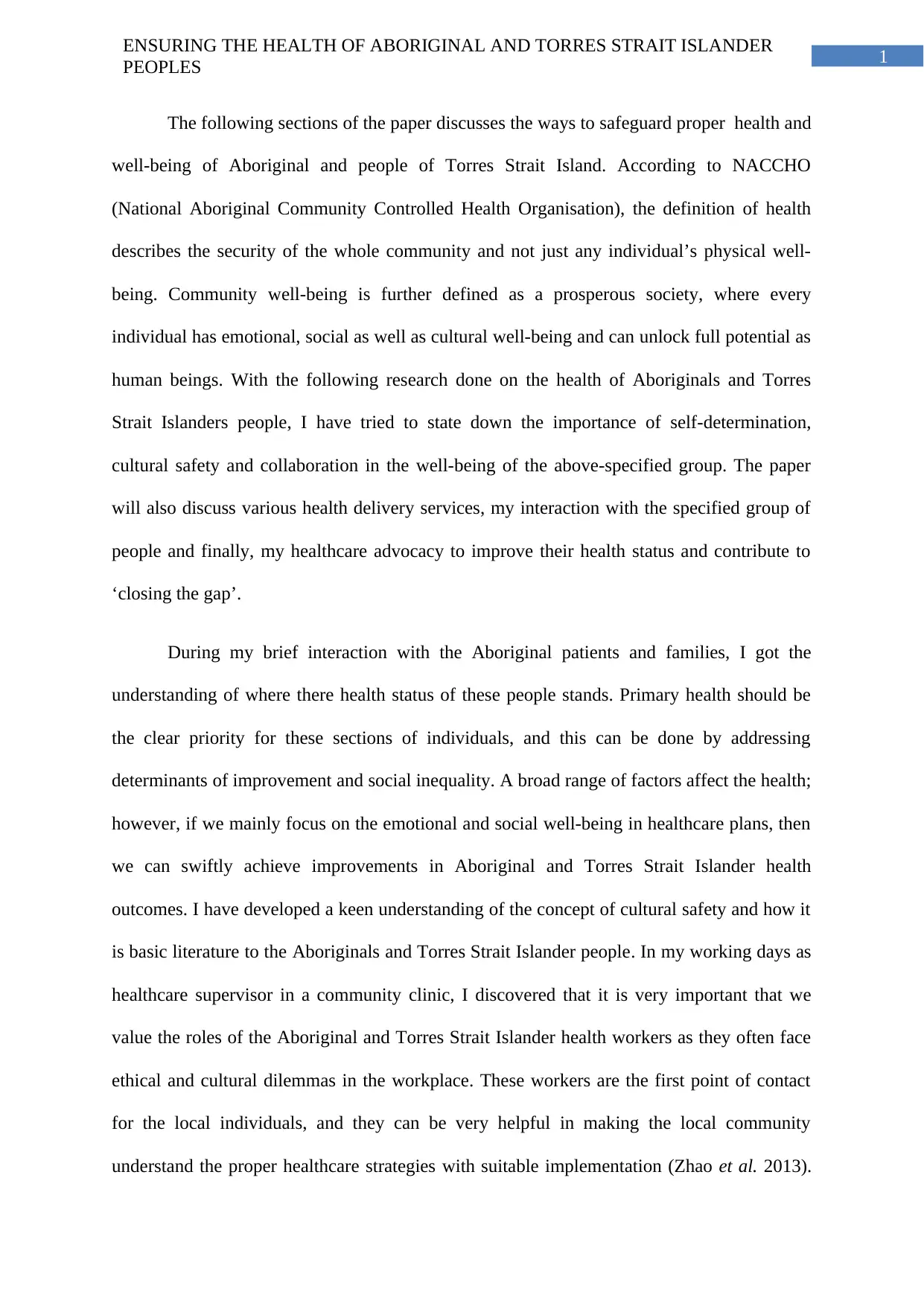
1
ENSURING THE HEALTH OF ABORIGINAL AND TORRES STRAIT ISLANDER
PEOPLES
The following sections of the paper discusses the ways to safeguard proper health and
well-being of Aboriginal and people of Torres Strait Island. According to NACCHO
(National Aboriginal Community Controlled Health Organisation), the definition of health
describes the security of the whole community and not just any individual’s physical well-
being. Community well-being is further defined as a prosperous society, where every
individual has emotional, social as well as cultural well-being and can unlock full potential as
human beings. With the following research done on the health of Aboriginals and Torres
Strait Islanders people, I have tried to state down the importance of self-determination,
cultural safety and collaboration in the well-being of the above-specified group. The paper
will also discuss various health delivery services, my interaction with the specified group of
people and finally, my healthcare advocacy to improve their health status and contribute to
‘closing the gap’.
During my brief interaction with the Aboriginal patients and families, I got the
understanding of where there health status of these people stands. Primary health should be
the clear priority for these sections of individuals, and this can be done by addressing
determinants of improvement and social inequality. A broad range of factors affect the health;
however, if we mainly focus on the emotional and social well-being in healthcare plans, then
we can swiftly achieve improvements in Aboriginal and Torres Strait Islander health
outcomes. I have developed a keen understanding of the concept of cultural safety and how it
is basic literature to the Aboriginals and Torres Strait Islander people. In my working days as
healthcare supervisor in a community clinic, I discovered that it is very important that we
value the roles of the Aboriginal and Torres Strait Islander health workers as they often face
ethical and cultural dilemmas in the workplace. These workers are the first point of contact
for the local individuals, and they can be very helpful in making the local community
understand the proper healthcare strategies with suitable implementation (Zhao et al. 2013).
ENSURING THE HEALTH OF ABORIGINAL AND TORRES STRAIT ISLANDER
PEOPLES
The following sections of the paper discusses the ways to safeguard proper health and
well-being of Aboriginal and people of Torres Strait Island. According to NACCHO
(National Aboriginal Community Controlled Health Organisation), the definition of health
describes the security of the whole community and not just any individual’s physical well-
being. Community well-being is further defined as a prosperous society, where every
individual has emotional, social as well as cultural well-being and can unlock full potential as
human beings. With the following research done on the health of Aboriginals and Torres
Strait Islanders people, I have tried to state down the importance of self-determination,
cultural safety and collaboration in the well-being of the above-specified group. The paper
will also discuss various health delivery services, my interaction with the specified group of
people and finally, my healthcare advocacy to improve their health status and contribute to
‘closing the gap’.
During my brief interaction with the Aboriginal patients and families, I got the
understanding of where there health status of these people stands. Primary health should be
the clear priority for these sections of individuals, and this can be done by addressing
determinants of improvement and social inequality. A broad range of factors affect the health;
however, if we mainly focus on the emotional and social well-being in healthcare plans, then
we can swiftly achieve improvements in Aboriginal and Torres Strait Islander health
outcomes. I have developed a keen understanding of the concept of cultural safety and how it
is basic literature to the Aboriginals and Torres Strait Islander people. In my working days as
healthcare supervisor in a community clinic, I discovered that it is very important that we
value the roles of the Aboriginal and Torres Strait Islander health workers as they often face
ethical and cultural dilemmas in the workplace. These workers are the first point of contact
for the local individuals, and they can be very helpful in making the local community
understand the proper healthcare strategies with suitable implementation (Zhao et al. 2013).

2
ENSURING THE HEALTH OF ABORIGINAL AND TORRES STRAIT ISLANDER
PEOPLES
However, the occurrence of such cultural dilemmas has led to higher burnout rates, and we
need to eliminate these cultural indifferences. We can use the expertise of these local
healthcare workers to connect to the local community at deeper levels and then further
develop cultural safe health services, all the while improving the whole healthcare system of
this community. To understand the cultural building capacity of Aboriginal and Torres Strait
Islander people, I first started by acknowledging the key groups of people and the
organisations of importance. Then, I tried to connect with these groups and establish proper
engagement as one of theirs. This helped me recognise the attitude and diversity of the
cultures in the key groups. I got to learn that these groups have autonomy over their lives,
which directed me to respect their sense of pride and self-determination. It is important that
we acknowledge their history and life experience and understand cultural safety, i.e. whether
they feel safe to be themselves, from their own perspective. To be one of them, all I did was
to engage with one of their staffs and create an environment where their beliefs and culture
are respected. I noted that many indigenous communities were located in remote areas and
other discrete geographic settlements too, living in other dominant culture. A community
profile including local individuals is an excellent approach to lay down the foundation of
active engagement, which can crucial to employ future healthcare strategies. This community
profile will first start with all their workers getting briefed about the history of the specific
community, their geographical boundaries, the key individuals of the community (like the
elders) and understanding the government protocols for working with such community. The
program’s aims like individual care for specific members of the family, a framework of the
program (including design, development, implementation and evaluation) and its effect on
Aboriginals and Torres Strait Islanders should be announced clearly before approaching the
group.
ENSURING THE HEALTH OF ABORIGINAL AND TORRES STRAIT ISLANDER
PEOPLES
However, the occurrence of such cultural dilemmas has led to higher burnout rates, and we
need to eliminate these cultural indifferences. We can use the expertise of these local
healthcare workers to connect to the local community at deeper levels and then further
develop cultural safe health services, all the while improving the whole healthcare system of
this community. To understand the cultural building capacity of Aboriginal and Torres Strait
Islander people, I first started by acknowledging the key groups of people and the
organisations of importance. Then, I tried to connect with these groups and establish proper
engagement as one of theirs. This helped me recognise the attitude and diversity of the
cultures in the key groups. I got to learn that these groups have autonomy over their lives,
which directed me to respect their sense of pride and self-determination. It is important that
we acknowledge their history and life experience and understand cultural safety, i.e. whether
they feel safe to be themselves, from their own perspective. To be one of them, all I did was
to engage with one of their staffs and create an environment where their beliefs and culture
are respected. I noted that many indigenous communities were located in remote areas and
other discrete geographic settlements too, living in other dominant culture. A community
profile including local individuals is an excellent approach to lay down the foundation of
active engagement, which can crucial to employ future healthcare strategies. This community
profile will first start with all their workers getting briefed about the history of the specific
community, their geographical boundaries, the key individuals of the community (like the
elders) and understanding the government protocols for working with such community. The
program’s aims like individual care for specific members of the family, a framework of the
program (including design, development, implementation and evaluation) and its effect on
Aboriginals and Torres Strait Islanders should be announced clearly before approaching the
group.
⊘ This is a preview!⊘
Do you want full access?
Subscribe today to unlock all pages.

Trusted by 1+ million students worldwide
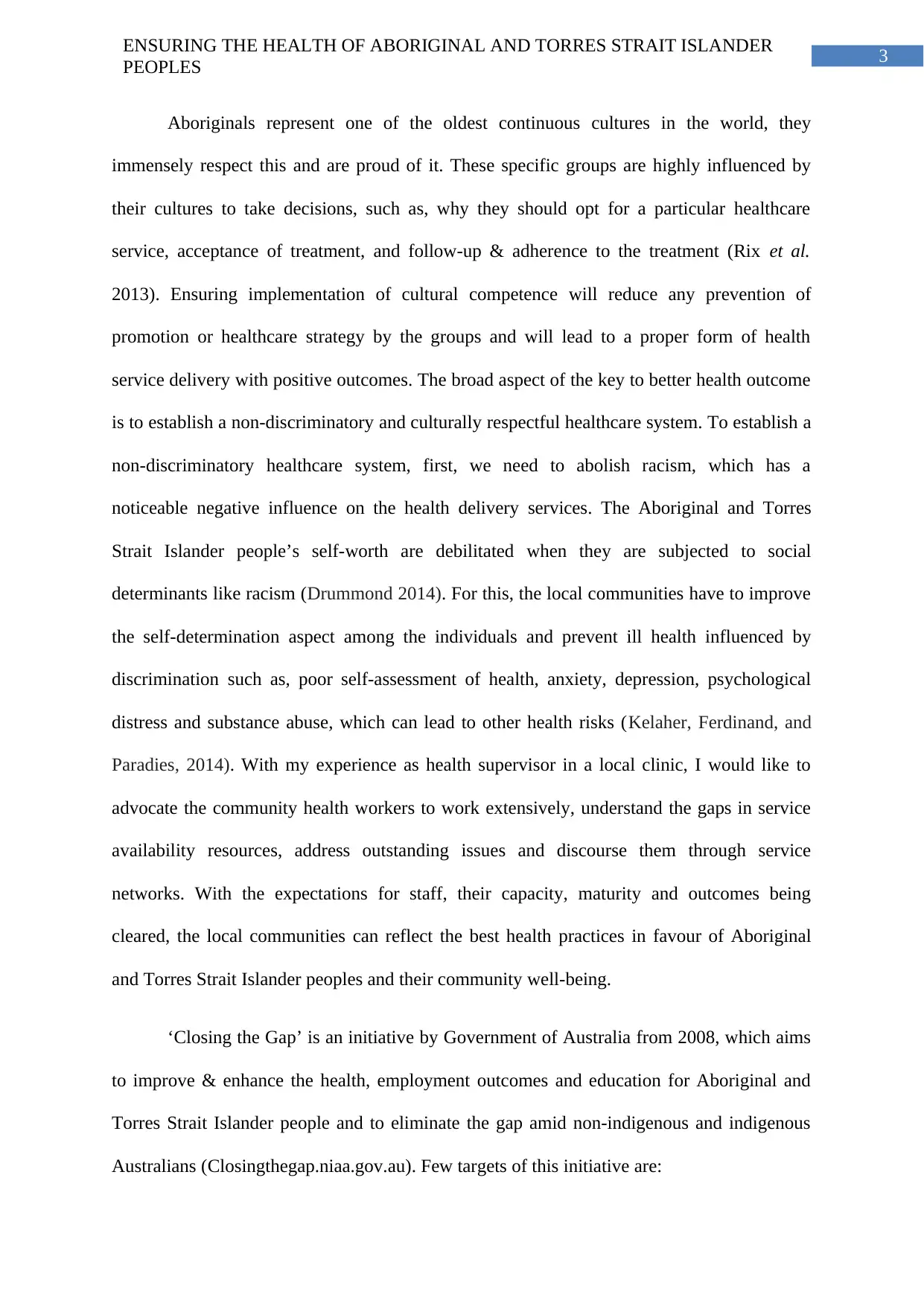
3
ENSURING THE HEALTH OF ABORIGINAL AND TORRES STRAIT ISLANDER
PEOPLES
Aboriginals represent one of the oldest continuous cultures in the world, they
immensely respect this and are proud of it. These specific groups are highly influenced by
their cultures to take decisions, such as, why they should opt for a particular healthcare
service, acceptance of treatment, and follow-up & adherence to the treatment (Rix et al.
2013). Ensuring implementation of cultural competence will reduce any prevention of
promotion or healthcare strategy by the groups and will lead to a proper form of health
service delivery with positive outcomes. The broad aspect of the key to better health outcome
is to establish a non-discriminatory and culturally respectful healthcare system. To establish a
non-discriminatory healthcare system, first, we need to abolish racism, which has a
noticeable negative influence on the health delivery services. The Aboriginal and Torres
Strait Islander people’s self-worth are debilitated when they are subjected to social
determinants like racism (Drummond 2014). For this, the local communities have to improve
the self-determination aspect among the individuals and prevent ill health influenced by
discrimination such as, poor self-assessment of health, anxiety, depression, psychological
distress and substance abuse, which can lead to other health risks (Kelaher, Ferdinand, and
Paradies, 2014). With my experience as health supervisor in a local clinic, I would like to
advocate the community health workers to work extensively, understand the gaps in service
availability resources, address outstanding issues and discourse them through service
networks. With the expectations for staff, their capacity, maturity and outcomes being
cleared, the local communities can reflect the best health practices in favour of Aboriginal
and Torres Strait Islander peoples and their community well-being.
‘Closing the Gap’ is an initiative by Government of Australia from 2008, which aims
to improve & enhance the health, employment outcomes and education for Aboriginal and
Torres Strait Islander people and to eliminate the gap amid non-indigenous and indigenous
Australians (Closingthegap.niaa.gov.au). Few targets of this initiative are:
ENSURING THE HEALTH OF ABORIGINAL AND TORRES STRAIT ISLANDER
PEOPLES
Aboriginals represent one of the oldest continuous cultures in the world, they
immensely respect this and are proud of it. These specific groups are highly influenced by
their cultures to take decisions, such as, why they should opt for a particular healthcare
service, acceptance of treatment, and follow-up & adherence to the treatment (Rix et al.
2013). Ensuring implementation of cultural competence will reduce any prevention of
promotion or healthcare strategy by the groups and will lead to a proper form of health
service delivery with positive outcomes. The broad aspect of the key to better health outcome
is to establish a non-discriminatory and culturally respectful healthcare system. To establish a
non-discriminatory healthcare system, first, we need to abolish racism, which has a
noticeable negative influence on the health delivery services. The Aboriginal and Torres
Strait Islander people’s self-worth are debilitated when they are subjected to social
determinants like racism (Drummond 2014). For this, the local communities have to improve
the self-determination aspect among the individuals and prevent ill health influenced by
discrimination such as, poor self-assessment of health, anxiety, depression, psychological
distress and substance abuse, which can lead to other health risks (Kelaher, Ferdinand, and
Paradies, 2014). With my experience as health supervisor in a local clinic, I would like to
advocate the community health workers to work extensively, understand the gaps in service
availability resources, address outstanding issues and discourse them through service
networks. With the expectations for staff, their capacity, maturity and outcomes being
cleared, the local communities can reflect the best health practices in favour of Aboriginal
and Torres Strait Islander peoples and their community well-being.
‘Closing the Gap’ is an initiative by Government of Australia from 2008, which aims
to improve & enhance the health, employment outcomes and education for Aboriginal and
Torres Strait Islander people and to eliminate the gap amid non-indigenous and indigenous
Australians (Closingthegap.niaa.gov.au). Few targets of this initiative are:
Paraphrase This Document
Need a fresh take? Get an instant paraphrase of this document with our AI Paraphraser

4
ENSURING THE HEALTH OF ABORIGINAL AND TORRES STRAIT ISLANDER
PEOPLES
Increase the life expectancy and reduce the gap in this generation by 2031.
For aboriginal children, lower the mortality rate to half by 2018.
Increasing the literacy rate in indigenous children and reducing the gap by half.
I personally feel that the foremost way to ensure that that closing the gap comes out to
be an effecting initiative is to set up a cultural safety framework which particularly aims to
develop the practical guidance and implement cultural safety strategies. The pre-requisite
principles to ensure effectiveness and sustainability of this framework are restoring equity
and social justice, identifying Aboriginal self-determination, reciprocity and negotiable
partnership, cultural contextuality and political bipartnership. We should encourage both the
indigenous and non-indigenous set of individuals to participate in campaigns against social
determinants like racism & discrimination (Herring et al. 2013). For this, I prefer the
implementation of Anti-Racism Strategy, which takes care of the discriminatory government
policies that have always put the Aboriginal and Torres Strait Islander people in a historical
disadvantage. Next thing is to increasing the effort in ‘Closing The Gap’ and also in the
consistency & accuracy of Aboriginal and Torres Strait Islander people data (Parker and
Milroy 2014). The latter can be achieved by increased identification and by enhancing the
research data collection & evaluation practices. For the mental and social well-being of the
community and its people, I suggest counselling to be conducted along with early
intervention services, which should be done with the help of local individuals in the
workforce (Department of Health, Australia 2013).
From the above information and discussion based on my ground experience with the
Aboriginal and Torres Strait Islander peoples, it can be concluded that ensuring self-
determination, cultural security and through association with different workforces, we can
establish the highest form of health status for the indigenous people of Australia. Constant
guidance and respecting their cultural practices can help the healthcare systems to obtain
ENSURING THE HEALTH OF ABORIGINAL AND TORRES STRAIT ISLANDER
PEOPLES
Increase the life expectancy and reduce the gap in this generation by 2031.
For aboriginal children, lower the mortality rate to half by 2018.
Increasing the literacy rate in indigenous children and reducing the gap by half.
I personally feel that the foremost way to ensure that that closing the gap comes out to
be an effecting initiative is to set up a cultural safety framework which particularly aims to
develop the practical guidance and implement cultural safety strategies. The pre-requisite
principles to ensure effectiveness and sustainability of this framework are restoring equity
and social justice, identifying Aboriginal self-determination, reciprocity and negotiable
partnership, cultural contextuality and political bipartnership. We should encourage both the
indigenous and non-indigenous set of individuals to participate in campaigns against social
determinants like racism & discrimination (Herring et al. 2013). For this, I prefer the
implementation of Anti-Racism Strategy, which takes care of the discriminatory government
policies that have always put the Aboriginal and Torres Strait Islander people in a historical
disadvantage. Next thing is to increasing the effort in ‘Closing The Gap’ and also in the
consistency & accuracy of Aboriginal and Torres Strait Islander people data (Parker and
Milroy 2014). The latter can be achieved by increased identification and by enhancing the
research data collection & evaluation practices. For the mental and social well-being of the
community and its people, I suggest counselling to be conducted along with early
intervention services, which should be done with the help of local individuals in the
workforce (Department of Health, Australia 2013).
From the above information and discussion based on my ground experience with the
Aboriginal and Torres Strait Islander peoples, it can be concluded that ensuring self-
determination, cultural security and through association with different workforces, we can
establish the highest form of health status for the indigenous people of Australia. Constant
guidance and respecting their cultural practices can help the healthcare systems to obtain
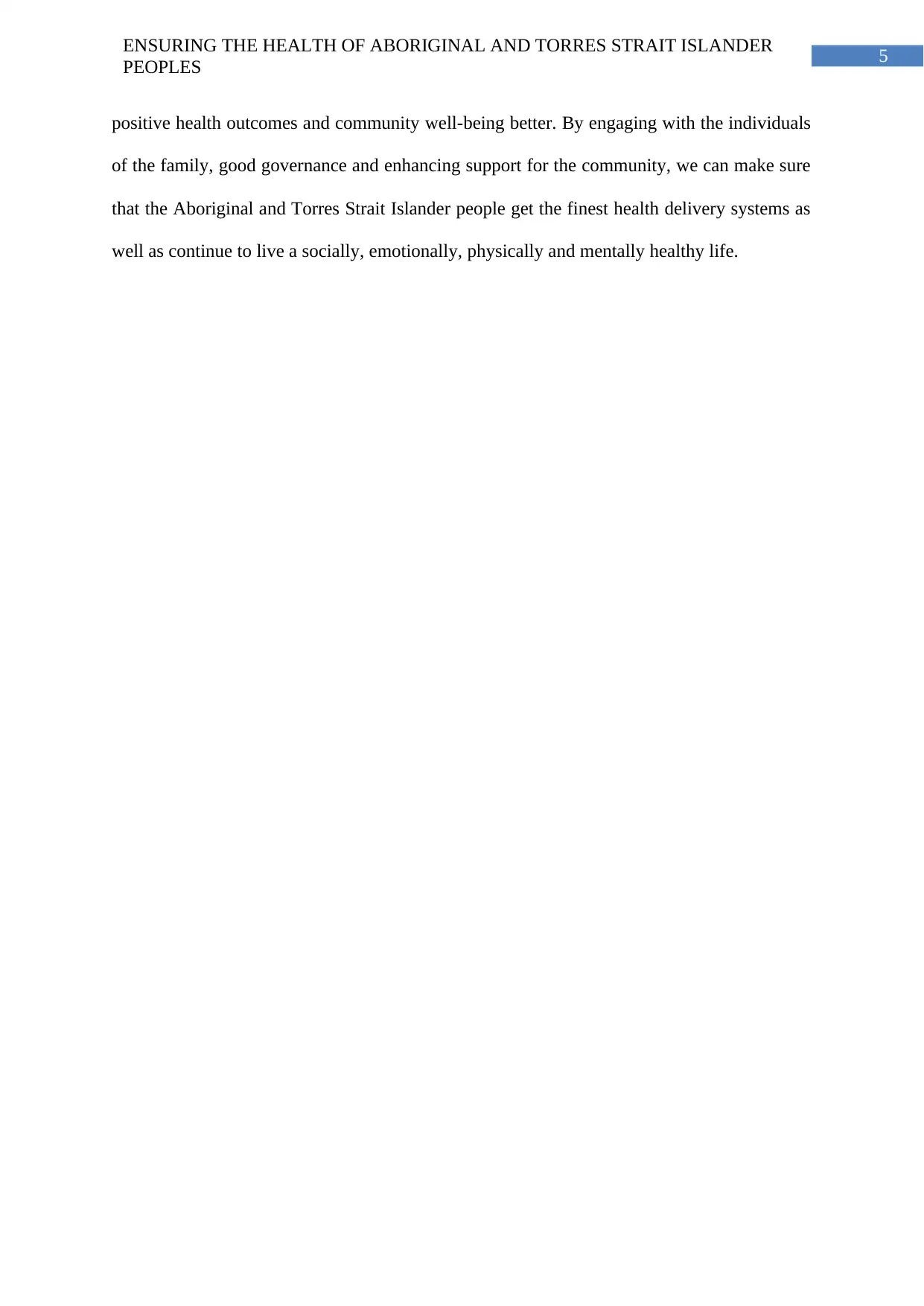
5
ENSURING THE HEALTH OF ABORIGINAL AND TORRES STRAIT ISLANDER
PEOPLES
positive health outcomes and community well-being better. By engaging with the individuals
of the family, good governance and enhancing support for the community, we can make sure
that the Aboriginal and Torres Strait Islander people get the finest health delivery systems as
well as continue to live a socially, emotionally, physically and mentally healthy life.
ENSURING THE HEALTH OF ABORIGINAL AND TORRES STRAIT ISLANDER
PEOPLES
positive health outcomes and community well-being better. By engaging with the individuals
of the family, good governance and enhancing support for the community, we can make sure
that the Aboriginal and Torres Strait Islander people get the finest health delivery systems as
well as continue to live a socially, emotionally, physically and mentally healthy life.
⊘ This is a preview!⊘
Do you want full access?
Subscribe today to unlock all pages.

Trusted by 1+ million students worldwide
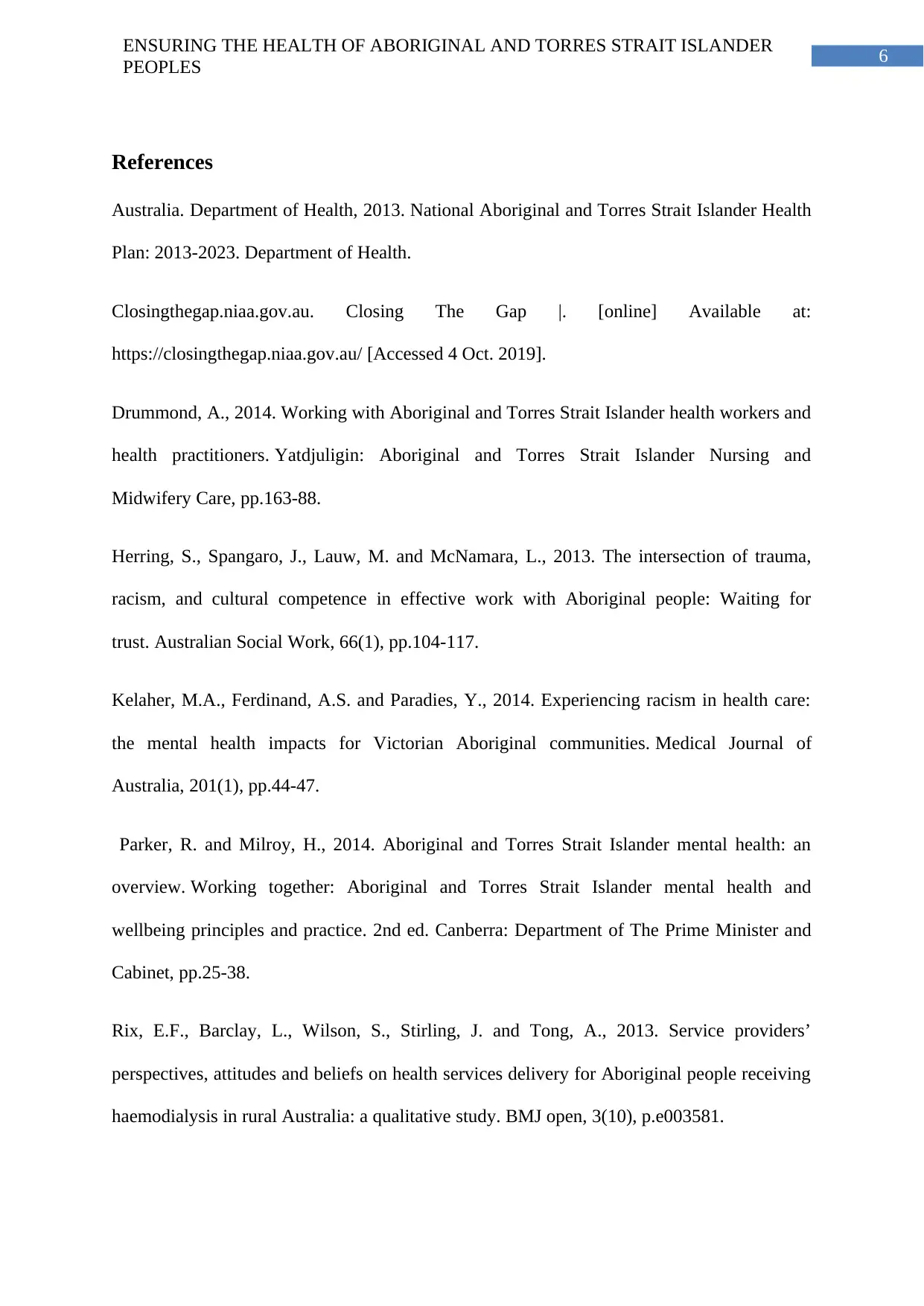
6
ENSURING THE HEALTH OF ABORIGINAL AND TORRES STRAIT ISLANDER
PEOPLES
References
Australia. Department of Health, 2013. National Aboriginal and Torres Strait Islander Health
Plan: 2013-2023. Department of Health.
Closingthegap.niaa.gov.au. Closing The Gap |. [online] Available at:
https://closingthegap.niaa.gov.au/ [Accessed 4 Oct. 2019].
Drummond, A., 2014. Working with Aboriginal and Torres Strait Islander health workers and
health practitioners. Yatdjuligin: Aboriginal and Torres Strait Islander Nursing and
Midwifery Care, pp.163-88.
Herring, S., Spangaro, J., Lauw, M. and McNamara, L., 2013. The intersection of trauma,
racism, and cultural competence in effective work with Aboriginal people: Waiting for
trust. Australian Social Work, 66(1), pp.104-117.
Kelaher, M.A., Ferdinand, A.S. and Paradies, Y., 2014. Experiencing racism in health care:
the mental health impacts for Victorian Aboriginal communities. Medical Journal of
Australia, 201(1), pp.44-47.
Parker, R. and Milroy, H., 2014. Aboriginal and Torres Strait Islander mental health: an
overview. Working together: Aboriginal and Torres Strait Islander mental health and
wellbeing principles and practice. 2nd ed. Canberra: Department of The Prime Minister and
Cabinet, pp.25-38.
Rix, E.F., Barclay, L., Wilson, S., Stirling, J. and Tong, A., 2013. Service providers’
perspectives, attitudes and beliefs on health services delivery for Aboriginal people receiving
haemodialysis in rural Australia: a qualitative study. BMJ open, 3(10), p.e003581.
ENSURING THE HEALTH OF ABORIGINAL AND TORRES STRAIT ISLANDER
PEOPLES
References
Australia. Department of Health, 2013. National Aboriginal and Torres Strait Islander Health
Plan: 2013-2023. Department of Health.
Closingthegap.niaa.gov.au. Closing The Gap |. [online] Available at:
https://closingthegap.niaa.gov.au/ [Accessed 4 Oct. 2019].
Drummond, A., 2014. Working with Aboriginal and Torres Strait Islander health workers and
health practitioners. Yatdjuligin: Aboriginal and Torres Strait Islander Nursing and
Midwifery Care, pp.163-88.
Herring, S., Spangaro, J., Lauw, M. and McNamara, L., 2013. The intersection of trauma,
racism, and cultural competence in effective work with Aboriginal people: Waiting for
trust. Australian Social Work, 66(1), pp.104-117.
Kelaher, M.A., Ferdinand, A.S. and Paradies, Y., 2014. Experiencing racism in health care:
the mental health impacts for Victorian Aboriginal communities. Medical Journal of
Australia, 201(1), pp.44-47.
Parker, R. and Milroy, H., 2014. Aboriginal and Torres Strait Islander mental health: an
overview. Working together: Aboriginal and Torres Strait Islander mental health and
wellbeing principles and practice. 2nd ed. Canberra: Department of The Prime Minister and
Cabinet, pp.25-38.
Rix, E.F., Barclay, L., Wilson, S., Stirling, J. and Tong, A., 2013. Service providers’
perspectives, attitudes and beliefs on health services delivery for Aboriginal people receiving
haemodialysis in rural Australia: a qualitative study. BMJ open, 3(10), p.e003581.
Paraphrase This Document
Need a fresh take? Get an instant paraphrase of this document with our AI Paraphraser
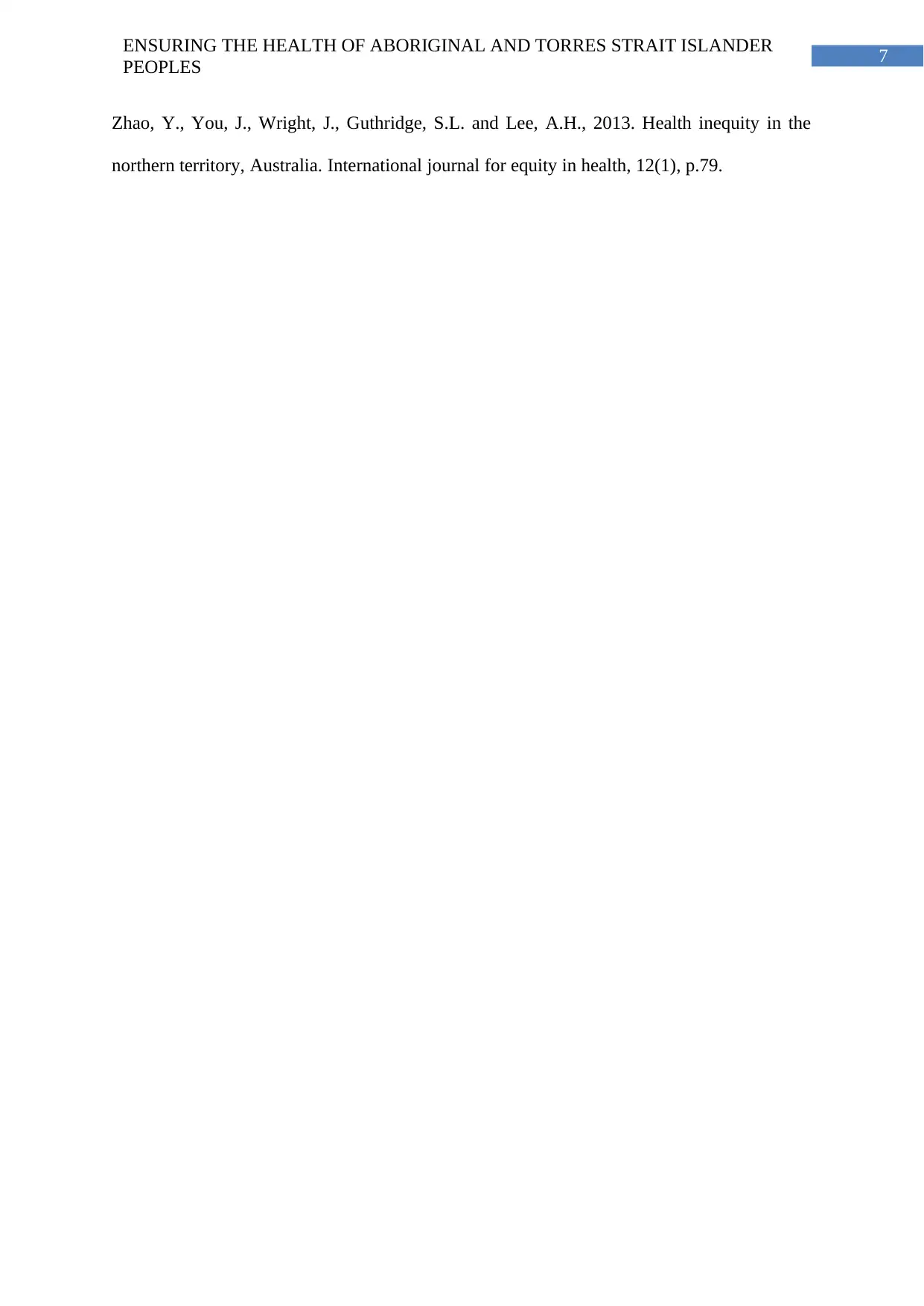
7
ENSURING THE HEALTH OF ABORIGINAL AND TORRES STRAIT ISLANDER
PEOPLES
Zhao, Y., You, J., Wright, J., Guthridge, S.L. and Lee, A.H., 2013. Health inequity in the
northern territory, Australia. International journal for equity in health, 12(1), p.79.
ENSURING THE HEALTH OF ABORIGINAL AND TORRES STRAIT ISLANDER
PEOPLES
Zhao, Y., You, J., Wright, J., Guthridge, S.L. and Lee, A.H., 2013. Health inequity in the
northern territory, Australia. International journal for equity in health, 12(1), p.79.
1 out of 8
Related Documents
Your All-in-One AI-Powered Toolkit for Academic Success.
+13062052269
info@desklib.com
Available 24*7 on WhatsApp / Email
![[object Object]](/_next/static/media/star-bottom.7253800d.svg)
Unlock your academic potential
Copyright © 2020–2025 A2Z Services. All Rights Reserved. Developed and managed by ZUCOL.





